Abstract
Urbanization and industrialization increase the concentrations of heavy metals in soils, which affect human health. A total of 127 topsoil samples were collected from the massively urbanized and industrialized district of Shanghai: Baoshan District. The sampling sites were isolated based on the land-use practice: industrial area, roadside area, residential area, and agricultural area. The absolute concentrations of heavy metals (Zn, Cr, Ni, Mn, Cu, Pb, and Cd) were determined using atomic absorption spectrometry and compared with Shanghai and the National soil background values. The geoaccumulation index (Igeo) and Nemerow pollution index were used to determine the existence and severity of the pollution of heavy metals. Enrichment factor (EF) analysis, spatial variability of pollution, and multivariate statistical analyses also were employed to determine the anthropogenic loading of heavy metals, their spatial dependency, and correlation among their sources, respectively. Moreover, potential ecological risk and human health risk [carcinogenic risk (RI) and noncarcinogenic hazard (HI)] were evaluated. The average concentration of all the metals (accounted as 229, 128, 56, 719, 55, 119, and 0.3 mg kg−1 for Zn, Cr, Ni, Mn, Cu, Pb, and Cd, respectively) was many folds higher than the background values. The indices depicted that the pollution exists in all the sites and severity decreases in the following order: industrial soils > roadside soil > residential soils > agricultural soils. However, Zn, Pb, and Cd showed high levels of pollution in all the soils. The EF values suggested that the majority of heavy metals are anthropogenically loaded; spatial variability showed that the pollution is more concentrated in Songnan town; Pearson’s correlation, principal component analysis (PCA), and cluster analysis suggested different sources of origin for the majority of the heavy metals. RI of Cr and Pb ranged between 2.8E−04 and 2.7E−07. However, HI was site-specific (only for Cr, Pb, Mn), and most of the sites were in Songnan town. This study could be used as a significant piece of information for management purposes to prevent heavy metal pollution and to protect human health.







Similar content being viewed by others
Change history
17 August 2017
An erratum to this article has been published.
References
Aslam J, Khan SA, Khan SH (2013) Heavy metals contamination in roadside soil near different traffic signals in Dubai, United Arab Emirates. J Saudi Chem Soc 17:315–319
Bloemena M-L, Markert B, Lieth H (1995) The distribution of Cd, Cu, Pb and Zn in topsoils of Osnabruck in relation to land use. Sci Total Environ 166:137–148
Cambardella CA, Moorman TB, Novak JM et al (1994) Field-scale variability of soil properties in central Iowa soils. Soil Sci Soc Am J 58:1501–1511
Canadian Ministry of the Environment (2011) Soil, ground water and sediment standards for use under XV.1 part of the environmental protection act. Canadian Ministry of the Environment, Toronto
Chabukdhara M, Nema AK (2013) Heavy metals assessment in urban soil around industrial clusters in Ghaziabad, India: probabilistic health risk approach. Ecotoxicol Environ Saf 87:57–64
Chu W, Qiu S, Xu J (2016) Temperature change of Shanghai and its response to global warming and urbanization. Atoms 7:114. doi:10.3390/atmos7090114
Dankoub Z, Ayoubi S, Khademi H, Sheng-Gao L (2012) Spatial distribution of magnetic properties and selected heavy metals in calcareous soils as affected by land use in the Isfahan region, central Iran. Pedosphere 22:33–47
Davis HT, Aelion CM, McDermott S, Lawson AB (2009) Identifying natural and anthropogenic sources of metals in urban and rural soils using GIS-based data, PCA, and spatial interpolation. Environ Pollut 157:2378–2385
Environment Protection Authority of Australia (2012) Classification and management of contaminated soil for disposal. In: Environment Protection Authority of Australia (ed) Information bulletin 105. Environment Protection Authority of Australia, Hobart
Fei M, Min L, Tong-guang S (2008) Evaluation on environmental quality of heavy metals in agricultural soils of Shanghai. Environ Sci 29:428–433 (in Chinese)
GB15618-1995 (1995) Environmental quality standard for soils. Ministry of Environmental Protection of China, Beijing
Gu Y-G, Gao Y-P, Lin Q (2016) Contamination, bioaccessibility and human health risk of heavy metals in exposed-lawn soils from 28 urban parks in southern China’s largest city, Guangzhou. Appl Geochem 67:52–58
Håkanson L (1980) An ecological risk index for aquatic pollution control—a sedimentological approach. Water Res 14:975–1001
He Z, Shentu J, Yang X et al (2015) Heavy metal contamination of soils: sources, indicators, and assessment. J Environ Indic 9:17–18
Hjortenkrans D, Bergback B, Haggerud A (2006) New metal emission patterns in road traffic environments. Environ Monit Assess 117:85–98
Hoffmann V, Knab M, Appel E (1999) Magnetic susceptibility mapping of roadside pollution. J Geochem Explor 66:313–326
Hu X-F, Su Y, Ye R et al (2007) Magnetic properties of the urban soils in Shanghai and their environmental implications. Catena 70:428–436
Hu Y, Liu X, Bai J et al (2013) Assessing heavy metal pollution in the surface soils of a region that had undergone three decades of intense industrialization and urbanization. Environ Sci Pollut Res 20:6150–6159
Huang CL, Bao LJ, Luo P et al (2016) Potential health risk for residents around a typical e-waste recycling zone via inhalation of size-fractionated particle-bound heavy metals. J Hazard Mater 317:449–456
Isen H, Altundag H, Keskin CS (2013) Determination of heavy metal contamination in roadside surface soil by sequential extraction. Pol J Environ Stud 22:1381–1385
Islam S, Ahmed K, Habibullah Al M, Masunaga S (2015) Potential ecological risk of hazardous elements in different land-use urban soils of Bangladesh. Sci Total Environ 512–513:94–102
Jiang Y, Chao S, Liu J et al (2017) Source apportionment and health risk assessment of heavy metals in soil for a township in Jiangsu Province, China. Chemosphere 168:1658–1668
Jie-liang C, Zhou S, You-wei Z (2007) Assessment and mapping of environmental quality in agricultural soils of Zhejiang province, China. J Environ Sci 19:50–54
Johansson C, Norman M, Burman L (2009) Road traffic emission factors for heavy metals. Atmos Environ 43:4681–4688
Kamunda C, Mathuthu M, Madhuku M (2016) Health risk assessment of heavy metals in soils from Witwatersrand gold mining basin. Int J Environ Res Public Health, South Africa, p 13
Lanphear BP, Matte TD, Rogers J et al (1998) The contribution of lead-contaminated house dust and residential soil to children’s blood levels. Environ Res 79:51–68
Li Z, Ma Z, van der Kuijp TJ et al (2014) A review of soil heavy metal pollution from mines in China: pollution and health risk assessment. Sci Total Environ 468–469:843–853
Liu D, Ma J, Sun Y, Li Y (2016) Spatial distribution of soil magnetic susceptibility and correlation with heavy metal pollution in Kaifeng City, China. Catena 139:53–60
Loska K, Cebula J, Pelczer J et al (1995) Use of enrichment and contamination factors together with geoaccumulation indexes to evaluate the content of Cd, Cu and Ni in the Rybnik water reservoir in Poland. Water Air Soil Pollut 93:347–365
Lu Y, Zhu F, Chen J (2007) Chemical fractionation of heavy metals in urban soils of Guangzhou, China. Environ Monit Assess 134:429–439
Man YB, Sun XL, Zhao YG et al (2010) Health risk assessment of abandoned agricultural soils based on heavy metal contents in Hong Kong, the world’s most populated city. Environ Int 36:570–576
McLaughlin MJ, Zarcinas BA, Stevens DP, Cook N (2000) Soil testing for heavy metals. Comm Soil Sci Plant Anal 31:1661–1700
MEP (2014) Technical guidelines for risk assessment of contaminated sites. (HJ 25.3-2014), The People’s Republic of China
Müller G (1969) Index of geoaccumulation in sediments of the Rhine river. Geol J 2:108–118
Naimi S, Ayoubi S (2013) Vertical and horizontal distribution of magnetic susceptibility and metal contents in an industrial district of central Iran. J Appl Geophys 96:55–66
Nezhad MTK, Tabatabaii SM, Gholami A (2015) Geochemical assessment of steel smelter-impacted urban soils, Ahvaz. Iran. J Geochem Explor 152:91–109
Ogunkunle CO, Fatoba PO (2013) Pollution loads and the ecological risk assessment of soil heavy metals around a mega cement factory in southwest Nigeria. Pol J Environ Stud 22:487–493
Oves M, Saghir Khan M, Huda Qari A, Nadeen Felemban M, Almeelbi T (2016) Heavy metals: biological importance and detoxification strategies. J Bioremediation Biodegrad. doi:10.4172/2155-6199.1000334
Oyetibo GO, Miyauchi K, Huang Y et al (2016) Biotechnological remedies for the estuarine environment polluted with heavy metals and persistent organic pollutants. Int Biodeterior Biodegrad. doi:10.1016/j.ibiod.2016.11.016 (in press)
Peng X, Shi G, Liu G et al (2017) Source apportionment and heavy metal health risk (HMHR) quantification from sources in a southern city in China, using an ME2-HMHR model. Environ Pollut 221:335–342
Peralta-Videa JR, Lopez ML, Narayan M et al (2009) The biochemistry of environmental heavy metal uptake by plants: implications for the food chain. Int J Biochem Cell Biol 41:1665–1677
Pichtel J, Sawyerr HT, Czarnowska K (1997) Spatial and temporal distribution of metals in soils in Warsaw, Poland. Environ Pollut 98:169–174
Qing X, Yutong Z, Shenggao L (2015) Assessment of heavy metal pollution and human health risk in urban soils of steel industrial city (Anshan), Liaoning, Northeast China. Ecotoxicol Environ Saf 120:377–385
Rashed MN (2010) Monitoring of contaminated toxic and heavy metals, from mine tailings through age accumulation, in soil and some wild plants at Southeast Egypt. J Hazard Mater 178:739–746
Ravisankar R, Sivakumar S, Chandrasekaran A et al (2015) Statistical assessment of heavy metal pollution in sediments of east coast of Tamilnadu using energy dispersive X-ray fluorescence spectroscopy (EDXRF). Appl Radiat Isot 102:42–47
Standards BL (2009) Environmental site assessment guideline. DB11/T 656-2009 (in Chinese)
Sungur A, Özcan H (2014) Chemometric and geochemical study of the heavy metal accumulation in the soils of a salt marsh area (Kavak Delta, NW Turkey). J Soils Sediments 15:323–331
Tang Z, Zhang L, Huang Q et al (2015) Contamination and risk of heavy metals in soils and sediments from a typical plastic waste recycling area in North China. Ecotoxicol Environ Saf 122:343–351
Tomlinson DL, Wilson JG, Harris CR, Jeffrey DW (1980) Problems in the assessment of heavy-metal levels in estuaries and the formation of a pollution index. Helgol Meeresunters 33:566–575
Tonga STY, Lamb KC (2000) Home sweet home? A case study of household dust contamination in Hong Kong. Sci Total Environ 256:115–123
Toth G, Hermann T, Da Silva MR, Montanarella L (2016) Heavy metals in agricultural soils of the European Union with implications for food safety. Environ Int 88:299–309
Uduma AU, Awagu EF (2013) Manganese as a reference element for the assessment of Zinc enrichment and depletion is selected farming soils of Nigeria. Res J Environ Earth Sci 5:497–504
USEPA (1986) Superfund public health evaluation manual. 540, Washington, DC, pp 1–86
USEPA (1989) Risk assessment guidance for superfund. Human health evaluation manual (part A), vol. I. EPA/540/1-89/002, Washington
USEPA (2001) Baseline human health risk assessment. Vasquez Boulevard and I-70 superfund site Denever, Denever
Wang Z, Pang Z, Guo Q et al (2013) Introducing a land-use-based spatial analysis method for human health risk evaluation of soil heavy metals. Environ Earth Sci 70:3225–3235
Wei B, Yang L (2010) A review of heavy metal contaminations in urban soils, urban road dusts and agricultural soils from China. Microchem J 94:99–107
Wu S, Peng S, Zhang X et al (2015) Levels and health risk assessments of heavy metals in urban soils in Dongguan, China. J Geochem Explor 148:71–78
Xia X, Chen X, Liu R, Liu H (2011) Heavy metals in urban soils with various types of land use in Beijing, China. J Hazard Mater 186:2043–2050
Xue JL, Zhi YY, Yang LP et al (2014) Positive matrix factorization as source apportionment of soil lead and cadmium around a battery plant (Changxing County, China). Environ Sci Pollut Res 21:7698–7707
Zhu Z, Sun G, Bi X et al (2013) Identification of trace metal pollution in urban dust from kindergartens using magnetic, geochemical and lead isotopic analyses. Atmos Environ 77:9–15
Acknowledgements
The authors thank Professor XueFeng Hu for his guideline and his laboratory, @Shanghai University, P. R. China, for providing the assistance for several lab testings of all the soil samples.
Author information
Authors and Affiliations
Corresponding authors
Additional information
The original version of this article was revised: Fan Luo, Rong Ye and Xue-feng Hu were not listed among the authors. The correct information is given below: Syed Taseer Abbas Jaffar, Fan Luo, Rong Ye, Hassan Younas, Xue-feng Hu, Long-zhu Chen.
An erratum to this article is available at https://doi.org/10.1007/s00244-017-0442-5.
Electronic Supplementary Material
Below is the link to the electronic supplementary material.
Rights and permissions
About this article
Cite this article
Jaffar, S.T.A., Luo, F., Ye, R. et al. The Extent of Heavy Metal Pollution and Their Potential Health Risk in Topsoils of the Massively Urbanized District of Shanghai. Arch Environ Contam Toxicol 73, 362–376 (2017). https://doi.org/10.1007/s00244-017-0433-6
Received:
Accepted:
Published:
Issue Date:
DOI: https://doi.org/10.1007/s00244-017-0433-6




